This timeline features Premodern example of nanotechnology, as well as Modern Era discoveries and milestones in the field of nanotechnology.
Premodern Examples of Nanotechnologies
Early examples of nanostructured materials were based on craftsmen’s empirical understanding and manipulation of materials. Use of high heat was one common step in their processes to produce these materials with novel properties.
|
|
|
The Lycurgus Cup at the British Museum, lit from the outside (left) and from the inside (right) |
4th Century: The Lycurgus Cup (Rome) is an example of dichroic glass; colloidal gold and silver in the glass allow it to look opaque green when lit from outside but translucent red when light shines through the inside. (Images at left.)
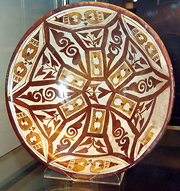 |
| Polychrome lustreware bowl, 9th C, Iraq, British Museum (©Trinitat Pradell 2008) |
9th-17th Centuries: Glowing, glittering “luster” ceramic glazes used in the Islamic world, and later in Europe, contained silver or copper or other metallic nanoparticles. (Image at right.)
 |
| The South rose window of Notre Dame Cathedral, ca 1250 |
6th-15th Centuries: Vibrant stained glass windows in European cathedrals owed their rich colors to nanoparticles of gold chloride and other metal oxides and chlorides; gold nanoparticles also acted as photocatalytic air purifiers. (Image at left.)
13th-18th Centuries: “Damascus” saber blades contained carbon nanotubes and cementite nanowires—an ultrahigh-carbon steel formulation that gave them strength, resilience, the ability to hold a keen edge, and a visible moiré pattern in the steel that give the blades their name. (Images below.)
 |
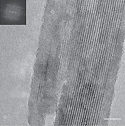 |
| (Left) A Damascus saber (photo by Tina Fineberg for The New York Times). (Right) High-resolution transmission electron microscopy image of carbon nanotubes in a genuine Damascus sabre after dissolution in hydrochloric acid, showing remnants of cementite nanowires encapsulated by carbon nanotubes (scale bar, 5 nm) (M. Reibold, P. Paufler, A. A. Levin, W. Kochmann, N. Pätzke & D. C. Meyer, Nature 444, 286, 2006). | |
Examples of Discoveries and Developments Enabling Nanotechnology in the Modern Era
These are based on increasingly sophisticated scientific understanding and instrumentation, as well as experimentation.
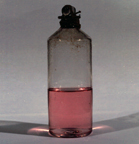 |
| "Ruby" gold colloid (Gold Bulletin 2007 40,4, p. 267) |
1857: Michael Faraday discovered colloidal “ruby” gold, demonstrating that nanostructured gold under certain lighting conditions produces different-colored solutions.
1936: Erwin Müller, working at Siemens Research Laboratory, invented the field emission microscope, allowing near-atomic-resolution images of materials.
1947: John Bardeen, William Shockley, and Walter Brattain at Bell Labs discovered the semiconductor transistor and greatly expanded scientific knowledge of semiconductor interfaces, laying the foundation for electronic devices and the Information Age.
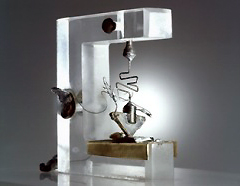 |
| 1947 transistor, Bell Labs |
1950: Victor La Mer and Robert Dinegar developed the theory and a process for growing monodisperse colloidal materials. Controlled ability to fabricate colloids enables myriad industrial uses such as specialized papers, paints, and thin films, even dialysis treatments.
1951: Erwin Müller pioneered the field ion microscope, a means to image the arrangement of atoms at the surface of a sharp metal tip; he first imaged tungsten atoms.
1956: Arthur von Hippel at MIT introduced many concepts of—and coined the term—“molecular engineering” as applied to dielectrics, ferroelectrics, and piezoelectrics
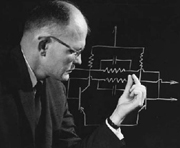 |
| Jack Kilby, about 1960. |
1958: Jack Kilby of Texas Instruments originated the concept of, designed, and built the first integrated circuit, for which he received the Nobel Prize in 2000. (Image at left.)
 |
| Richard Feynman (Caltech archives) |
1959: Richard Feynman of the California Institute of Technology gave what is considered to be the first lecture on technology and engineering at the atomic scale, "There's Plenty of Room at the Bottom" at an American Physical Society meeting at Caltech. (Image at right.)
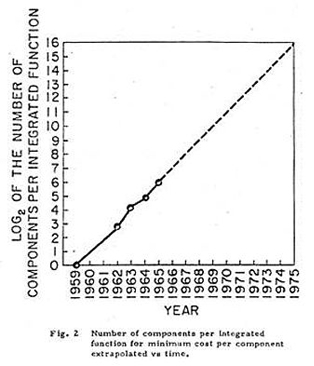 |
|
Moore's first public graph showing his vision of the semiconductor industry being able to "cram more components onto integrated circuits" |
1965: Intel co-founder Gordon Moore described in Electronics magazine several trends he foresaw in the field of electronics. One trend now known as “Moore’s Law,” described the density of transistors on an integrated chip (IC) doubling every 12 months (later amended to every 2 years). Moore also saw chip sizes and costs shrinking with their growing functionality—with a transformational effect on the ways people live and work. That the basic trend Moore envisioned has continued for 50 years is to a large extent due to the semiconductor industry’s increasing reliance on nanotechnology as ICs and transistors have approached atomic dimensions.1974: Tokyo Science University Professor Norio Taniguchi coined the term nanotechnology to describe precision machining of materials to within atomic-scale dimensional tolerances. (See graph at left.)
1981: Gerd Binnig and Heinrich Rohrer at IBM’s Zurich lab invented the scanning tunneling microscope, allowing scientists to "see" (create direct spatial images of) individual atoms for the first time. Binnig and Rohrer won the Nobel Prize for this discovery in 1986.
1981: Russia’s Alexei Ekimov discovered nanocrystalline, semiconducting quantum dots in a glass matrix and conducted pioneering studies of their electronic and optical properties.
1985: Rice University researchers Harold Kroto, Sean O’Brien, Robert Curl, and Richard Smalley discovered the Buckminsterfullerene (C60), more commonly known as the buckyball, which is a molecule resembling a soccer ball in shape and composed entirely of carbon, as are graphite and diamond. The team was awarded the 1996 Nobel Prize in Chemistry for their roles in this discovery and that of the fullerene class of molecules more generally. (Artist's rendering at right.)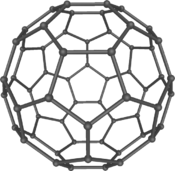
1985: Bell Labs’s Louis Brus discovered colloidal semiconductor nanocrystals (quantum dots), for which he shared the 2008 Kavli Prize in Nanotechnology.
1986: Gerd Binnig, Calvin Quate, and Christoph Gerber invented the atomic force microscope, which has the capability to view, measure, and manipulate materials down to fractions of a nanometer in size, including measurement of various forces intrinsic to nanomaterials.
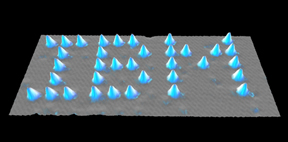
1989: Don Eigler and Erhard Schweizer at IBM's Almaden Research Center manipulated 35 individual xenon atoms to spell out the IBM logo. This demonstration of the ability to precisely manipulate atoms ushered in the applied use of nanotechnology. (Image at left.)
1991: Sumio Iijima of NEC is credited with discovering the carbon nanotube (CNT), although there were early observations of tubular carbon structures by others as well. Iijima shared the Kavli Prize in Nanoscience in 2008 for this advance and other advances in the field. CNTs, like buckyballs, are entirely composed of carbon, but in a tubular shape. They exhibit extraordinary properties in terms of strength, electrical and thermal conductivity, among others. (Image below.)
 |
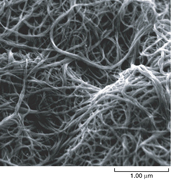 |
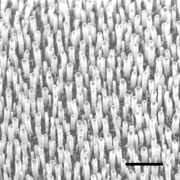 |
| Carbon nanotubes (courtesy, National Science Foundation). The properties of CNTs are being explored for applications in electronics, photonics, multifunctional fabrics, biology (e.g., as a scaffold to grow bone cells), and communications. See a 2009 Discovery Magazine article for other examples | SEM micrograph of purified nanotube "paper" in which the nanotubes are the fibers (scale bar, 0.001 mm) (courtesy, NASA). | An array of aligned carbon nanotubes, which can act like a radio antenna for detecting light at visible wave- lengths (scale bar 0.001 mm) (courtesy, K. Kempa, Boston College). |
1992: C.T. Kresge and colleagues at Mobil Oil discovered the nanostructured catalytic materials MCM-41 and MCM-48, now used heavily in refining crude oil as well as for drug delivery, water treatment, and other varied applications.
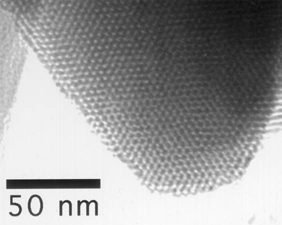 |
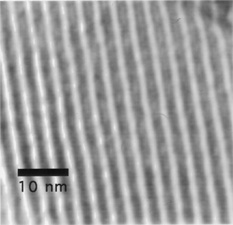 |
| MCM-41 is a "mesoporous molecular sieve" silica nanomaterial with a hexagonal or "honeycomb" arrangement of its straight cylindrical pores, as shown in this TEM image (courtesy of Thomas Pauly, Michigan State University). | This TEM image of MCM-41 looks at the straight cylindrical pores as they lie perpendicular to the viewing axis (courtesy of Thomas Pauly, Michigan State University). |
1993: Moungi Bawendi of MIT invented a method for controlled synthesis of nanocrystals (quantum dots), paving the way for applications ranging from computing to biology to high-efficiency photovoltaics and lighting. Within the next several years, work by other researchers such as Louis Brus and Chris Murray also contributed methods for synthesizing quantum dots.
1998: The Interagency Working Group on Nanotechnology (IWGN) was formed under the National Science and Technology Council to investigate the state of the art in nanoscale science and technology and to forecast possible future developments. The IWGN’s study and report, Nanotechnology Research Directions: Vision for the Next Decade (1999) defined the vision for and led directly to formation of the U.S. National Nanotechnology Initiative in 2000.
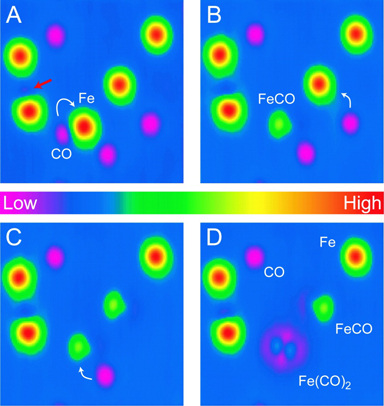 |
| The progression of steps of using a scanning tunneling microscope tip to "assemble" an iron carbonyl molecule, beginning with Fe (iron) and CO (carbon monoxide) molecules (A), joining them to produce FeCO (B), then adding a second CO molecule (C), to achieve the FECO2 molecule (D). (H.J. Lee, W. Ho, Science 286, 1719 [1999].) |
1999: Cornell University researchers Wilson Ho and Hyojune Lee probed secrets of chemical bonding by assembling a molecule [iron carbonyl Fe(CO)2] from constituent components [iron (Fe) and carbon monoxide (CO)] with a scanning tunneling microscope. (Image at left.)
1999: Chad Mirkin at Northwestern University invented dip-pen nanolithography® (DPN®), leading to manufacturable, reproducible “writing” of electronic circuits as well as patterning of biomaterials for cell biology research, nanoencryption, and other applications. (Image below right.)
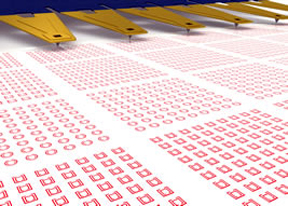 |
| Use of DPN to deposit biomaterials ©2010 Nanoink |
1999–early 2000’s: Consumer products making use of nanotechnology began appearing in the marketplace, including lightweight nanotechnology-enabled automobile bumpers that resist denting and scratching, golf balls that fly straighter, tennis rackets that are stiffer (therefore, the ball rebounds faster), baseball bats with better flex and "kick," nano-silver antibacterial socks, clear sunscreens, wrinkle- and stain-resistant clothing, deep-penetrating therapeutic cosmetics, scratch-resistant glass coatings, faster-recharging batteries for cordless electric tools, and improved displays for televisions, cell phones, and digital cameras.
2000: President Clinton launched the National Nanotechnology Initiative (NNI) to coordinate Federal R&D efforts and promote U.S. competitiveness in nanotechnology. Congress funded the NNI for the first time in FY2001. The NSET Subcommittee of the NSTC was designated as the interagency group responsible for coordinating the NNI.
2003: Congress enacted the 21st Century Nanotechnology Research and Development Act (P.L. 108-153). The act provided a statutory foundation for the NNI, established programs, assigned agency responsibilities, authorized funding levels, and promoted research to address key issues.
 |
| Computer simulation of growth of gold nanoshell with silica core and over-layer of gold (courtesy N. Halas, Genome News Network, 2003) |
2003: Naomi Halas, Jennifer West, Rebekah Drezek, and Renata Pasqualin at Rice University developed gold nanoshells, which when “tuned” in size to absorb near-infrared light, serve as a platform for the integrated discovery, diagnosis, and treatment of breast cancer without invasive biopsies, surgery, or systemically destructive radiation or chemotherapy.
2005: Erik Winfree and Paul Rothemund from the California Institute of Technology developed theories for DNA-based computation and “algorithmic self-assembly” in which computations are embedded in the process of nanocrystal growth.
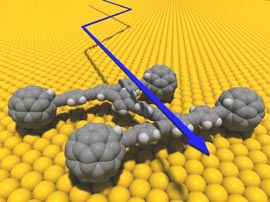 |
| Nanocar with turning buckyball wheels (credit: RSC, 29 March 2006). |
2006: James Tour and colleagues at Rice University built a nanoscale car made of oligo(phenylene ethynylene) with alkynyl axles and four spherical C60 fullerene (buckyball) wheels. In response to increases in temperature, the nanocar moved about on a gold surface as a result of the buckyball wheels turning, as in a conventional car. At temperatures above 300°C it moved around too fast for the chemists to keep track of it! (Image at left.)
2007: Angela Belcher and colleagues at MIT built a lithium-ion battery with a common type of virus that is nonharmful to humans, using a low-cost and environmentally benign process. The batteries have the same energy capacity and power performance as state-of-the-art rechargeable batteries being considered to power plug-in hybrid cars, and they could also be used to power personal electronic devices. (Image at right.)
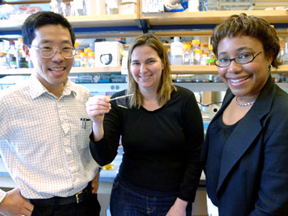 |
| (L to R) MIT professors Yet-Ming Chiang, Angela Belcher, and Paula Hammond display a virus-loaded film that can serve as the anode of a battery. (Photo: Donna Coveney, MIT News.) |
2009–2010: Nadrian Seeman and colleagues at New York University created several DNA-like robotic nanoscale assembly devices. One is a process for creating 3D DNA structures using synthetic sequences of DNA crystals that can be programmed to self-assemble using “sticky ends” and placement in a set order and orientation. Nanoelectronics could benefit: the flexibility and density that 3D nanoscale components allow could enable assembly of parts that are smaller, more complex, and more closely spaced. Another Seeman creation (with colleagues at China’s Nanjing University) is a “DNA assembly line.” For this work, Seeman shared the Kavli Prize in Nanoscience in 2010.
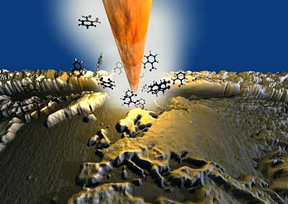 |
| A rendered image of a nanoscale silicon tip chiseling out the smallest relief map of the world from a substrate of organic molecular glass. Shown middle foreground is the Mediterranean Sea and Europe. (Image courtesy of Advanced Materials.) |
2010: IBM used a silicon tip measuring only a few nanometers at its apex (similar to the tips used in atomic force microscopes) to chisel away material from a substrate to create a complete nanoscale 3D relief map of the world one-one-thousandth the size of a grain of salt—in 2 minutes and 23 seconds. This activity demonstrated a powerful patterning methodology for generating nanoscale patterns and structures as small as 15 nanometers at greatly reduced cost and complexity, opening up new prospects for fields such as electronics, optoelectronics, and medicine. (Image at left.)
2012: George Church, of Harvard University, and colleagues Harvard, publish the first scientific article on DNA data storage: Next-Generation Digital Information Storage in DNA
2016: A research team led by Berkeley Lab material scientists creates a transistor with a working 1-nanometer gate, breaking a size barrier that had been set by the laws of physics: Smallest. Transistor. Ever.
2018: Physicists at MIT and Harvard University tuned graphene to behave at two electrical extremes: as an insulator, in which electrons are completely blocked from flowing; and as a superconductor, in which electrical current can stream through without resistance. Insulator or superconductor? Physicists find graphene is both
2019: Prof. Molly Stevens, from Imperial College of London, and Prof. Sangeeta Bhatia, from MIT, develop a novel diagnostic tool that reports on the presence of cancer by changing the color of urine, using nanosensors composed of gold nanoclusters tethered to protein carriers. Colour-change urine test for cancer shows potential in mouse study
2020: Researchers at Rice University discover that virtually any source of solid carbon — from food scraps to old car tires — can be turned into graphene, which are sheets of carbon atoms prized for applications ranging from high-strength plastic to flexible electronics. Rice lab turns trash into valuable graphene in a flash
2020: Lipid nanoparticles are used as drug delivery vehicles for the COVID-19 mRNA vaccines developed by Pfizer-BioNtech and Moderna. The mRNA vaccines would not have been possible without the use of lipid nanoparticles to deliver the mRNA inside cells and protect it from degradation.
2020: Scientists at Northwestern University develop a porous smart sponge that selectively soaks up oil in water. With an ability to absorb more than 30 times its weight in oil, the sponge could be used to inexpensively and efficiently clean up oil spills without harming marine life. The sponge can be reused dozens of times without losing its effectiveness. Smart sponge could clean up oil spills
2020: Researchers at MIT demonstrate that carbon nanotube field-effect transistors can be made swiftly in commercial facilities with the same equipment used to manufacture the silicon-based transistors that are the backbone of today's computing industry. Carbon nanotube transistors make the leap from lab to factory floor
2021: Researchers from the Kavli Institute at Cornell for Nanoscale Science, the U.S. Department of Energy’s Argonne National Laboratory, and international collaborators built an electron microscope pixel array detector that set a world record by doubling the resolution of state-of-the-art electron microscopes. Cornell researchers see atoms at record resolution
2021: IBM unveils world’s first 2-nanometer chip technology , opening a new frontier for semiconductors.
2021: A team of scientists from Harvard University and Nanyang Technological University in Singapore has developed a “smart” food packaging material that is biodegradable, sustainable, and kills harmful bacteria. The water-proof food packaging is composed of nanofibers infused with a cocktail of natural antimicrobial compounds. Keep food fresh with this bacteria-killing packaging
2022: Chemists at Rice University working with researchers at the Ford Motor Company have turned plastic parts from "end-of-life" vehicles into graphene via the university's flash Joule heating process. To test whether end-of-life, mixed plastic could be transformed, the scientists ground the shredder "fluff" made of plastic bumpers, gaskets, carpets, mats, seating, and door casings from end-of-life F-150 pickup trucks to a fine powder. Cars could get a ‘flashy’ upgrade
2023: With some careful twisting and stacking, physicists at the Massachusetts Institute of Technology and the National Institute for Materials Science in Tsukuba, Japan, reveal a new and exotic property in magic-angle graphene: superconductivity that can be turned on and off with an electric pulse, much like a light switch. Study: Superconductivity switches on and off in “magic-angle” graphene
2023: Researchers from the National Institute of Standards and Technology and the National Aeronautics and Space Administration’s Jet Propulsion Laboratory build a superconducting camera containing 400,000 pixels – 400 times more than any other device of its type. The camera is made up of grids of superconducting nanowires, cooled to near absolute zero, in which current moves with no resistance until a wire is struck by a photon. NIST Team Develops Highest-Resolution Single-Photon Superconducting Camera
2023: Moungi G. Bawendi (MIT), Louis E. Brus (Columbia University), and Alexei I. Ekimov (Nanocrystals Technology Inc.) are awarded the 2023 Nobel Prize in Chemistry for the discovery and synthesis of nanoparticles called quantum dots. They planted an important seed for nanotechnology




